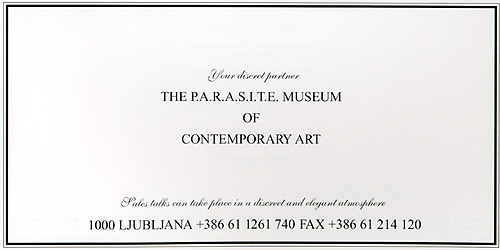
THE ZERO POINTThe representation of chaos can easely be imagined as a fascinating performance in which all parameters of time and space are instantly transposed and turned upside down. Hierarchies of meanings collapse, old norms disappear, universal truths become banal and senseless, societal and social codes are lost. The abrogated time, the abrogated geography. What used to be high up is low down now the; the periphery has moved to the centre, and the centre is cast out to the edge. Artefacts and projections of "the former" and "the present" paradoxically unite, shapes merge in something fantastically different. A catastrophe, or a new birth ?Claude Levi - Strauss speaks of "primitive" societies in which social meaning of objects and ideas has remained unchanged and modern throughout long periods, despite the passing of time. From the historical point of view, these cultures have reached the zero point which unites the past, the present, and the future. These ahistoric and static conditions efface a great deal of things which unites the past, the present, and the future. These ahistoric and static conditions efface a great deal of things which are hard to imagine, for instance the conception of aging , or renewal. These are societies which do not leave traces and in which things have mythical genealogy that exists independently of structures and notions of history.
THE DECEASEDThe showing off of the deceased is in a constant paradox. For more than two centuries it longs for the wholeness, it projects into the future its desire which, however, remains eternally unsatisfied. In the Western civilisation, history as an ideal manifestation of the notion of progress suffers from a peculiar duality, for its striving for preservation is directly opposed to the philosophy of surpassing and development.A museum collection is, by definition, "seperated" from the outer world, similarly as - in the tradition of this thought - the idea is separated from the matter, the meaning from the material bearer, the inner from the outer, the subject from the object. A museum is the most perfect materialisation of the opposition between the arts and the world. Probably it need not be specially pointed out: what is interior is transparent, conscious, orderly; and what is exterior is jumbled, incidental, vague. The Museum institution is the magical boundary, the frame which seperates. The border - line, which by itself is not yet art, but establishes the boundary that separates the things which are art already, from those which are not art anymore. To preserve the deceased ! But with preservation the thing itself eludes, slips away. What remains is a mere sign, an object, a cultural code. Perhaps preservation really is nothing but "simulated resistance" to loss...
LABORATORYWhen the laboratory enters the strictly confined territory (which, of course, also presumes a precisely defined network of relations, and an evident hierarchy) of the symbolic form, the latter has to open wide. A specific space is within the uncertain. The space for testing and investigation, with no safe shelter; all crumbled by its nature, without a centre, without "conclusion". In every moment exposed to the complete failure and collapse, to the "failed attempt". The rules in this connection are not yet invented, and we arduously have to establish them every time anew. The moving force of the laboratory is experience - daily, dirrect, alive. It chooses and moves things, constructs plants, and leaves colourful traces on smooth surfaces.
The laboratory splits the rigid groundplan of the Musem: only in the extraordinary composition of the new form they can surpass their own restriction and contrasts. This is not an incidental crossing, or collision, of the "absolutely different", but an analytical proce of some symbiosis. Where the first one lacks, the second one adds to it, and where the second one is perfect the first one twarts it.  |